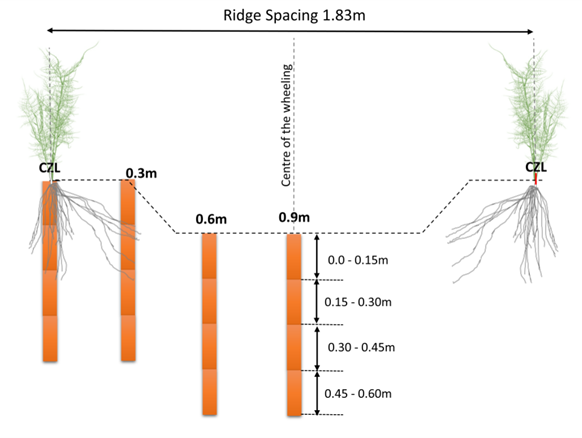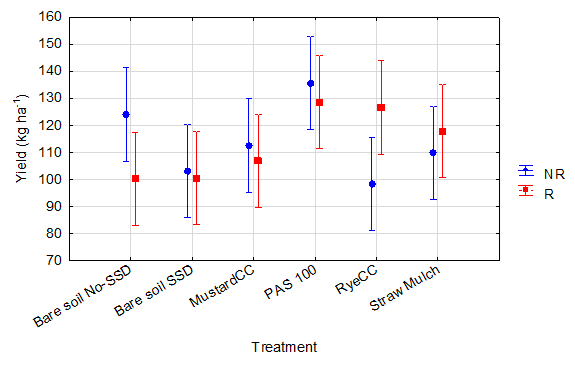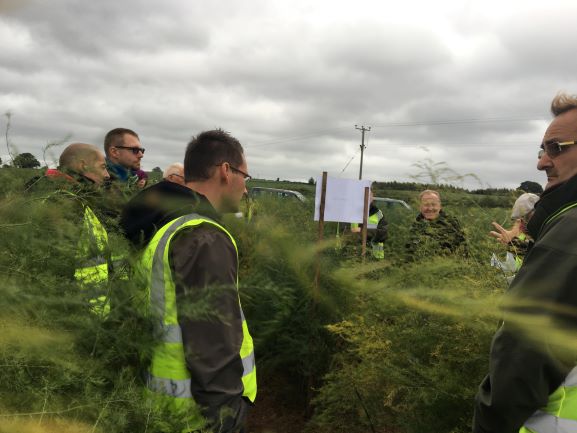Please click here to access the main AHDB website and other sectors.
Best management practices for asparagus
Tuesday, 23 March 2021
Field operations such as annual re-ridging in asparagus crops, spray operations and harvesting can result in progressive and severe compaction of inter-bed wheelings, leading to reduced infiltration and an increased risk of surface water ponding, run-off generation and soil erosion.
AHDB funded project FV 450 ‘Asparagus: Sustainable soil management for stand longevity and yield optimization’ (01/05/2016 – 31/03/2018), to develop and effectively disseminate a suite of Best Management Practices (BMPs) to prevent and/or remediate wheeling compaction and the issues it causes. The project was run by Dr Rob Simmons of the Cranfield Soil and Agrifood Institute, Cranfield University.
Two replicated field experiments were established in April 2016 at Gatsford Farm, Ross-on-Wye, with in-kind support from Cobrey Farms. BMPs included (1) companion crops - Rye (Sereale cecale L.), Mustard (Sinapis alba L.), (2) interrow surface mulch applications (straw mulch or PAS 100 compost in combination with shallow soil disturbance (SSD)) and (3) a combination of conventional tillage practices (re-ridging (R) and SSD) against (4) a zero-tillage option. Shallow Soil Disturbance was applied using a winged tine at 0.25 - 0.3 m depth in mulch treatments.
In Experiment 1 (48 experimental plots), the impact of the BMPs was studied in Gijnlim, which represents 70% of UK field grown asparagus crop. Experiment 2 compared varietal differences in root development and architecture and, root profile distribution as affected by sub-soiling treatments for Gijnlim and Guelph Millennium. Trial set up is given below -
Tables 1 - Experiment 1: Treatment descriptions
|
Variety |
Treatment description |
Re-ridging |
|
Gijnlim |
Companion Crop – rye |
R |
|
Gijnlim |
Companion Crop – rye |
NR |
|
Gijnlim |
Companion Crop – mustard |
R |
|
Gijnlim |
Companion Crop – mustard |
NR |
|
Gijnlim |
PAS 100 compost SSD |
R |
|
Gijnlim |
PAS 100 compost SSD |
NR |
|
Gijnlim |
Straw Mulch SSD |
R |
|
Gijnlim |
Straw Mulch SSD |
NR |
|
Gijnlim |
Bare soil SSD |
R |
|
Gijnlim |
Bare soil SSD |
NR |
|
Gijnlim |
Conventional Practice |
R |
|
Gijnlim |
Zero-tillage |
NR |
Annual re-ridging (R) or Zero-ridging (NR). Shallow soil disturbance (SSD). Treatments in bold are included in Experiment 2.
Experiment 2: Treatment descriptions
|
Variety |
Treatment description |
Re-ridging |
|
Gijnlim |
Bare soil SSD |
R |
|
Gijnlim |
Bare soil SSD |
NR |
|
Gijnlim |
*Conventional Practice |
R |
|
Gijnlim |
Zero-tillage |
NR |
|
Guelph Millennium |
Bare soil SSD |
R |
|
Guelph Millennium |
Bare soil SSD |
NR |
|
Guelph Millennium |
*Conventional Practice |
R |
|
Guelph Millennium |
Zero-tillage |
NR |
Annual re-ridging (R) or Zero-ridging (NR). Shallow soil disturbance (SSD). Treatments in bold are included from Experiment 1.
*Conventional practice is defined as annual re-ridging with no shallow soil disturbance applied to interrow wheelings.
Root architecture and root profile distributions were determined. Root cores were taken on the crown zero line (CZL) from between two plants in the row. Cores were also taken subsequently, away from the CZL, but in line with the crown at distances of 0.3 m, 0.6 m and 0.9 m (Figure 1). Root cores were extracted from the following soil depths: 0.00 - 0.15 m, 0.15 - 0.30 m, 0.30 - 0.45 m and 0.45 – 0.6 m.

Figure 1. Root coring protocol adopted at the FV 450 / FV 450a trial site.
The two year project indicated a strong trend for Gijnlim roots to expand more into the wheeling than Guelph Millennium but no significant differences in the spatial distribution of root mass densities were observed between the varieties. Limited harvesting to quantify yields showed that re-ridging did not reduce yield for either variety although results suggested that, for the young crop and wheelings on 1.83 m centres, subsoiling operations to 0.3 m depth were safe to undertake where either rye or mustard companion crops were grown. There was however risk of damaging 2-5% of the total root mass when sub-soiling in the wheelings at 0.175 cm depth for Guelph Millennium and at 0.3 m depth for Gijnlim.
Rye and mustard companion crops seemed to restrict the development of asparagus storage roots to the ridge zone, with less root growth in the surface (< 0.15 m) of wheelings. The rye / no-shallow soil disturbance non-ridged treatment yielded significantly lower (18.9 – 28.5% lower) than most other treatments. This reduction contrasted strongly with findings of North America asparagus growers.
High Penetromer Resistance values (PR>3 MPa) and high Bulk Density (BD>1.45 cm-3)
measurements were observed in the upper sub-soil in wheelings, which could impact asparagus root development. High BD recordings were also made for the mid top-soil. Historically, asparagus roots have been observed in soils with PR values of 1.96 MPa and 2.9 MPa). The impact of high PR and BD values on the growth of the asparagus storage root system and hence ability to store soluble carbohydrates is currently unknown.
The continuation project FV 450a (02/04 2018 – 02/04/2021) was undertaken as a PhD study by Lucie Maskova, under the supervision of Dr Rob Simmons, Dr Sarah De Baets and Dr Lynda Deeks at Cranfield. This continued to study the impacts of the FV450 treatments on yields, root development and architecture and also soluble carbohydrate levels in the root system and impacts on soil health. Varietal differences in root response to BMPs were evaluated and a wider asparagus root architecture survey covering diverse soil types, stand ages, different varieties and productions systems across the asparagus grower community was undertaken. Storage root carbohydrate levels were determined across sites and an assessment made of ‘root damage vulnerability’ for the specific crops surveyed.
FV 450a: Impact of BMPs on yield
The PAS 100 compost treatments (ridged and non-ridged in combination with shallow soil disturbance) were associated with a 20% uplift in asparagus spear yields as compared to conventional practice and rye non-ridged treatments. The rye non-ridged treatment continued to be associated with a 23% reduction in yield as compared to the rye ridged treatment (Figure 2).

Figure 2. Differences in 2020 Gijnlim yield (kg ha-1) between Experiment 1 treatments. Vertical bars denote 0.95 confidence intervals.
This provides robust evidence that where rye is grown as a companion crop and ridging cannot be undertaken, in the following spring a significant yield reduction can be expected. However, if ridging can be undertaken no yield penalty is observed as compared with conventional practice or zero-tillage. Based on these findings, growers may be unwilling to risk growing rye as a companion crop, in case weather / soil conditions mean they are not able to get onto the land to ridge.
The 2020 results followed the 2018 and 2019 findings that asparagus storage root carbohydrate values for Guelph Millennium are significantly higher than the equivalent for Gijnlim, irrespective of treatment. Despite some clear yield differences, there was no effect of treatments on root carbohydrate values in either 2019 or 2020.
Results also show that for both Gijnlim and Guelph Millennium, annual re-ridging associated with conventional practice led to a 20-24% reduction in yield as compared with the equivalent zero-tillage treatments. This may in part corroborate previous research showing that annual re-ridging causes root damage and yield reductions.
FV 450a: Impact on BMPs on soil compaction & infiltration
Conventional practice was associated with significantly higher penetrometer resistance (PR) values from 0.0-0.2 m depth, as compared to bare soil treatments. In contrast, significantly lower PR values across the soil profile from the zero-tillage treatment indicated less soil compaction as compared to all other bare soil treatments.
Companion cropping did not significantly affect PR as compared with conventional practice. This was unexpected, as based on previous published studies, companion cropping bioremediated soil structure.
In 2020, PR was significantly reduced in the interrow wheelings to 0.25 m depth for all shallow soil disturbance treatments. Furthermore, the straw mulch and PAS 100 compost treatments (applied in conjunction with shallow soil disturbance) resulted in significantly less compaction than conventional practice to depths greater than 0.5 m.
In 2020, infiltration rates in all treatments subject to shallow soil disturbance were classified as “Very Rapid” (>500 mm h1) and were significantly higher than for conventional practice (“Moderate”, 23.2 mm h-1).
The results suggest that the combination of mulch application (either PAS 100 Compost or straw) to interrow wheeling and shallow soil disturbance significantly reduces deep seated compaction and increases infiltration. This has implications for runoff and erosion control as well as soil moisture re-charge.
FV 450a: Impact of treatments on root architecture
Significant differences in whole profile root mass density (RMD) were observed between zero tillage and conventional practice treatments. This was due to significant differences in RMD at 0.15 – 0.30 m depth, 0.3, 0.6 and 0.9 m from the crown zero line. These differences amount to between a 48-98% increase in RMD associated with the zero-tillage treatment as compared with the conventional practice. This indicates that annual re-ridging damages storage roots. However, to date, no significant reduction in yield or increase in disease incidence has been observed in relation to this treatment.
Guelph Millennium is associated with a shallower rooting tendency as compared with Gijnlim. For the zero-tillage treatment, which essentially allows the asparagus root to grow undisturbed, Guelph Millennium is associated with 66-100% higher RMD at 0.0 – 0.15 m depth at 0.3 and 0.6 m from the crown zero line, as compared with Gijnlim.
Across all treatments, sub-soiling (shallow soil disturbance) in interrow wheelings could potentially damage up to 5% of the total root biomass under a range of tine configurations used at an operating depth of 300 mm. Annual ridging operations also have the potential to damage up to 5% of total root biomass.
FV 450a: Grower survey results
For fields sampled from the wider grower landbank, asparagus row spacings varied as a function of wheeling centres. Highest values of root mass were found at the crown zero line and up to 0.3m away from the ridge, and the lowest values in the wheeling in a ‘deadzone’ near the soil surface (0-0.3m). Variety was not a prevailing factor in root mass distribution, while stand age had a significant effect. Repeated re-ridging and sub-soiling in the wheelings prevented expansion of the root system in the wheeling zone thus causing significant ‘truncation’ of the potential root biomass achievable. This has implications for carbohydrate storage. Root mass was also negatively correlated with soil PR across all sampled locations and fields. The results continue to support the recommendation that in order to prevent storage root damage through re-ridging or subsoiling operations, growers should undertake exploratory root profile distribution surveys prior to commencing re-ridging and/or sub-soiling operations.
Further information
Download the project reports here


